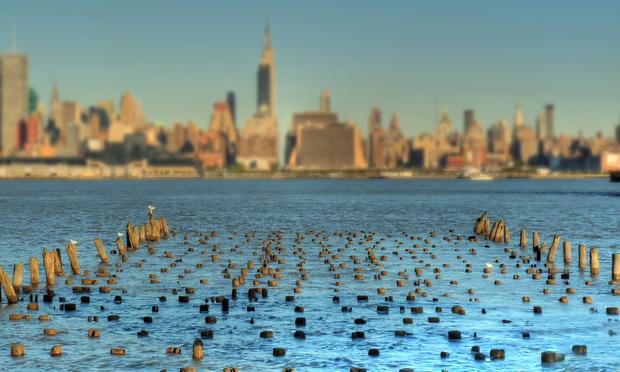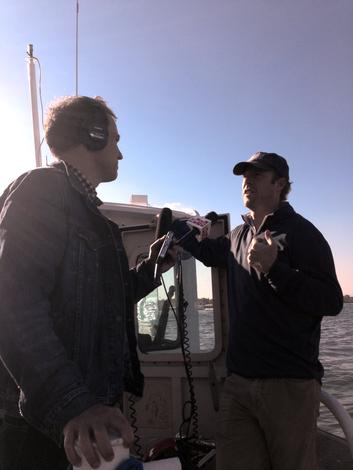NYC 2050: Climate Change and the Future of New York
Tuesday, December 30, 2014
Play
00:00 / 00:00
In 1524, the Italian explorer Giovanni da Verrazzano sailed into New York Harbor. A bevy of Lenape Indians dressed in colorful feathers came out in small boats to greet him. But before they could transact much business, according to historians Edwin Burrows and Mike Wallace, a storm rose up and chased the Europeans back out to safer waters. The Indians returned to land.
The Lenapes were well-suited for life in the Hudson estuary. They had no cellars or subway tunnels that could flood. If their footpaths became wet, they would dry out in the sun.
Not so for the Europeans who came next. They filled in land that was once water at the same time that the ocean’s height has risen – by a foot in the last century alone. They replaced trees with asphalt that traps heat and releases it slowly, turning heat waves into deadly all-night affairs.
These changes in the city’s climate are only going to accelerate. In our series NYC 2050, WNYC and NBC 4 New York have been exploring ways in which life will be different in or about the year 2050. According to the New York City Panel on Climate Change, our winters will become shorter and wetter, our summers longer and hotter. The Atlantic will keep rising, potentially turning some of those land-filled areas back into the wetlands they once were. The annual cost of dealing with severe weather will more than double – and that’s not counting when hurricanes actually hit the city’s shores.
“What we are going to see is a changed city,” said Daniel Zarrilli, the director of the city’s office of resiliency and recovery. “Climate change is going to impact every single New Yorker in lots of different ways.”
We chose the year 2050 for a reason: It is far enough away so that we can demonstrate dramatic changes in the climate, and yet near enough that many people alive today will still be living in the city. But make no mistake: climate change will continue to affect the city after that year as well – even if society takes drastic action today to curb greenhouse gas emissions.
An Aging City
By 2050, we will all be older, of course. The number of elderly will have grown tremendously by then – Cornell University researchers estimate nearly 1.5 million New Yorkers will be 65 or older. And heat, and heat waves, are particularly dangerous for old people: their health is frail. They live alone. They may be forgetful.
“I always tell them: ‘Make sure and drink a lot of water, ‘” said Balroop Pirmal, a driver for a meal delivery service for the Catholic Charities of Brooklyn and Queens. Drivers like him are often the only people who come by, physically, every day and see their elderly clients, day after day. When one of Pirmal’s opened her door a few years ago, he knew something was wrong.
“She was shivering,” he recalled. “The minute I saw her, I called the office and she had high blood pressure; her blood sugar was high. They rushed her to the hospital.”
According to Patrick Kinney, a researcher at Columbia University’s Mailman School of Public Health, between 1,200 and 1,500 people will likely die each summer from heat on average, unless adaptive efforts are made, such as increasing the use of air conditioners and improving alert systems. That’s four to five times as many as die on average each summer now.
Kinney and his colleagues based their research on mid-range projections by the New York City Panel on Climate Change, as does much of the reporting in the NYC 2050 series. The panel, a group of scientists from Columbia, Princeton, City University of New York and the region’s other leading research institutions, was convened by then-Mayor Mike Bloomberg in 2008 in to help the city prepare for the future. Their work was incorporated in “A Stronger, More Resilient New York,” Bloomberg’s 438-page plan to build sea walls and take other measures to strengthen the city.
Vicious Cycles
Some of the changes outlined by the climate panel threaten to put New Yorkers into a vicious cycle. Higher temperatures (about 5 degrees higher on average) mean more air conditioning – even the platforms on the Second Avenue subway will have them. And more energy demand will, in turn, increase the risk of blackouts, which would of course make air conditioners useless.
“Air conditioning penetration is going up as people get more affluent,” said Stuart Gaffin, a heat researcher at Columbia University. “Right now it’s hard to keep the electricity on, on some of those very, very hot days.”
Architect and real estate developers are working on some ways to help reduce the huge swings in power demand that make the city’s grid vulnerable. The Durst Organization's 1 Bryant Park building in Midtown, for example, has giant ice makers deep in its basement that freeze water at night when power is most plentiful (and cheap) and melts it during the day to cool off the building without stressing the grid.
City Built Upside Down
Sea level rise is yet another example of how ill-suited the city’s built environment has become to a changing climate. New York’s early inhabitants settled the waterfront, while developers in the 19th century founded cemeteries in some of the highest reaches of the city. Green-Wood, Cypress Hills and Maple Grove are all situated along the terminal moraine, a ridge running through Brooklyn and Queens left behind by glaciers thousands of years ago.
It made sense to develop the city that way at the time – who had heard about sea level rise back then? But now, says Klaus Jacob, a geophysicist at Columbia who also serves on the climate change panel, it is clear the city is built upside down.
“We put our ancestors when they die in the highest points in New York City,” he quipped during a recent visit to Woodlawn Cemetery in the Bronx (el. 210 feet). “And we live in the most at-risk places, in the low lands, on the waterfront.”
The irony is, New Yorkers are still doing that. Census records show low-elevation neighborhoods are gaining while some high-elevation areas are losing people. Bloomberg-era rezonings could add about 40,000 more people in the 100-year flood plain by opening up former industrial areas along the waterfront, like Greenpoint-Williamsburg, to residential development. To help make sure the new residents are safe, the City Council passed a law last year that would require the first habitable floors of new residential buildings to be built 2 feet above the expected 100-year flood level.
But Jacob points out that in 36 years, the sea level may have risen so much, that today’s 100-year flood would reach those ground floor residences, and given 50 or 80 years of sea level rise, a flood could ruin the electrical circuits.
Zarrrillil, the city’s resiliency director, says 2-foot requirement is a start, and that the city is pursuing other measures to keep damage to a minimum.
The question of just how high to build homes, sewage treatment plans or railway lines may sound arcane, but in the age of climate change, it will have a profound impact in the future. It is not an easy question to answer: preparing too much costs more in the short run; preparing too little may cost more in the long run.
“The quality of life in our city today was defined by the decisions we made 100 years ago or more – most obviously the subway system,” said William Solecki, the co-chairman of the New York City Panel on Climate Change and a geography professor at City University of New York. “So the New York of the future will be shaped by what we do in the next 10 to 15 years.”
The Lenape Indians had their own way of dealing with storms. They spent the warm months down by the shore and when stormier weather came, they would pack up their longhouses and climb the terminal moraine.


